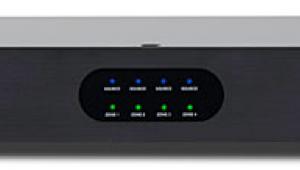Peachtree Audio iDecco Stereo Integrated Amplifier Page 2
 You can access all of the inputs via the front-panel buttons or the remote control. The small remote, with its pleasing plastic-velvet finish, includes iPod navigation buttons. The company is careful to note that the menu, plus, and minus buttons are currently inactive: “They have been included in case those functions or any additional functions for the iPod are made available to Peachtree Audio at some point in the future.” You must punch the menu navigation commands into the iPod directly. It’s fun watching the volume knob move, seemingly by itself, in response to the remote.
You can access all of the inputs via the front-panel buttons or the remote control. The small remote, with its pleasing plastic-velvet finish, includes iPod navigation buttons. The company is careful to note that the menu, plus, and minus buttons are currently inactive: “They have been included in case those functions or any additional functions for the iPod are made available to Peachtree Audio at some point in the future.” You must punch the menu navigation commands into the iPod directly. It’s fun watching the volume knob move, seemingly by itself, in response to the remote.
Also on the back panel are two noteworthy buttons. One controls the DAC’s anti-aliasing filter “for a sharp slope which measures better and a soft slope that is preferred by many audiophiles,” the manual says. I used the sharp slope. The other button adjusts the patented jitter-reduction circuit for narrow (low-jitter sources) or wide (high-jitter sources like an Apple Airport Express) bandwidth. It affects only the optical and coaxial inputs. The manual says a heav- ily jittered source may be silent in the narrow position. When I connected my CD player to coax in, I didn’t notice any difference, but that didn’t surprise me—the Rotel is a high-quality Red Book–compliant player. The iDecco’s DAC module alone has more than 450 components and 11 regulated power supplies. It reclocks the signal and resamples it into 24-bit/96-kilohertz for- mat before outputting through a line stage operating in Class A mode.
I put the iDecco through sev- eral stages of listening using both the Era Design 4 speakers on my desk and the Paradigm Reference Studio 20 v.4 in my main system. First I used it with the USB out from my Lenovo A61a PC with lossy MP3 and AAC audio files. Then I plugged my second-generation iPod touch into the dock for more lossy listening. Next, I switched to the CD player’s coax connection for my uncompressed digital audio fix. Finally, the iDecco moved from my desktop to the equipment rack for a couple of movies using the OPPO BD-83SE universal disc player—this is Home Theater magazine, after all. But your use of the product needn’t be limited to those options. Peachtree mentions Sonos, Squeezebox, Apple TV, Airport Express, and Sirius/XM, among others, as potential signal sources.
PC via USB
Black Light Syndrome is an album of “spontaneously composed” smart metal by Bozzio Levin Stevens. All of these musicians are heavy hitters: Terry Bozzio on drums, Tony Levin on bass and Chapman Stick, and Steve Stevens on guitar. Even when delivered to my PC in the form of iTunes AAC files, the music immediately benefitted from the smoothing iDecco treatment. I’ve always said that, even though they needn’t be, tubes are often implemented like a really great tone control with one setting. Because the mids were fairly gentle, I could crank the volume and get the most out of Levin’s virtuosic bass lines and Bozzio’s meaty but nimble drumming. This album has made me a fan of Stevens (better known as Billy Idol’s guitarist).
Thunder from the Blue Sky by the Vlatko Stefanovski Trio features guest guitarist Jan Akkerman. I would love to buy the CD, but Macedonian/Dutch blues albums are painfully rare. So for now, I have to settle for MP3 files at 192 kilobits per second via Windows Media Player. I’d guess that the album was recorded with a straightforward clarity, and that showed through even the degradation of MP3 encoding. But the iDecco mitigated the lossy audio codec’s harsh edge and let me absorb the blues standards and virtuosic guitar playing in a more relaxed spirit.
iPod via Dock
When I switched to the iPod
dock input, I tried my ostensibly incompatible first-generation nano. Surprise: It did produce sound, along with an “OK to unplug” message on its tiny screen. But my actual listening involved an officially supported second-generation iPod touch.
I was present for the live recording of Richard Thompson’s Small Town Romance at Folk City in New York. It’s a great artifact of Thompson’s 1982-vintage sound: an analog recording with his Martin guitar played into a micro- phone without any electronic pickups or digital processing (since replaced by a Lowden with all the mod cons). [The edit staff had to look this one up. It’s a British idiom for “All the modern conveniences.” Thanks Mark, for broadening our horizons yet again.—Ed.] What surprised me about the iPod-delivered MP3 192-kbps files was how much they sounded like the vinyl. They imparted a lifelike presence to Thompson’s voice and a naturalness to the unadorned acoustic guitar.
- Log in or register to post comments






























































